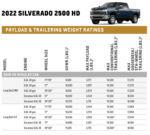The Dodge Ram 2500 heavy duty pickup truck is built for power, designed to take on the toughest jobs. With best-in-class torque and towing capabilities, the Ram 2500 allows you to haul heavy loads with confidence. But to get the most out of your truck, you need to understand its towing capacity.
In this comprehensive guide from the experts at Antich Automotive, we’ll cover everything you need to know about the 2018 Ram 2500 towing capacity. We’ll break down the numbers by cab, drivetrain, and engine so you can select the optimal configuration for your needs. Whether you’re pulling a boat, horse trailer, or fifth wheel RV, this article will ensure you stay within the safe limits of your truck.
Key Takeaways:
-
The 2018 Ram 2500 has a maximum conventional towing capacity of 17,980 lbs and a fifth wheel/gooseneck towing capacity of 25,300 lbs.
-
Towing capacity varies significantly based on cab style, drivetrain, engine, and axle ratio.
-
Payload capacity ranges from 3,366 lbs to 4,613 lbs depending on configuration. Payload must be factored in when determining actual towing capacity.
-
Dodge offers three engine options: 5.7L HEMI V8, 6.4L HEMI V8, and 6.7L Cummins turbo diesel. The Cummins provides the highest tow ratings.
-
4×4 drivetrain reduces towing capacity compared to 4×2. Mega Cab configs have the lowest ratings.
-
Towing capacity is calculated according to the SAE J2807 standard, factoring in curb weight, payload, passengers, options, and hitch weight.
Towing Basics: Weight Ratings and Safety
Before diving into the numbers for the 2500, it’s important to understand some key towing terms and how tow capacity is calculated:
GVWR (Gross Vehicle Weight Rating) – The maximum allowable weight of the fully loaded vehicle, including passengers, payload, and hitch weight. This number should not be exceeded.
GCWR (Gross Combined Weight Rating) – The maximum combined weight rating of the truck and trailer together. This is set by the manufacturer and should not be exceeded.
GAWR (Gross Axle Weight Rating) – The maximum weight each axle is designed to safely carry. Front and rear GAWRs are listed separately and should not be exceeded.
Curb Weight – The weight of the truck including a full tank of fuel and all standard equipment. It does not include passengers, cargo, or trailer tongue weight.
Payload Capacity – The maximum cargo and passenger weight the truck can carry. It’s calculated as GVWR minus curb weight. Payload typically ranges from 1,400 to 4,000+ lbs for the Ram 2500 depending on configuration.
Conventional Towing – Towing a trailer using a bumper hitch. Tongue weight is 10-15% of loaded trailer weight for conventional towing.
Fifth Wheel/Gooseneck Towing – Towing a trailer using a hitch mounted in the truck bed. Tongue weight is usually 15-25% of loaded trailer weight.
Tongue/Hitch Weight – The downward weight of the fully loaded trailer on the hitch. This counts as payload cargo when calculating tow capacity.
SAE J2807 – The towing capacity testing standard used by Ram and other manufacturers to determine safe, comparable tow ratings.
Exceeding any of the weight ratings when towing can overload the brakes, chassis, tires, or suspension of your truck. This leads to safety issues and excessive wear. Adhering to Ram’s towing capacity guidelines ensures your truck and trailer stay stable and under control.
2018 Ram 2500 Towing Capacity by Cab, Drivetrain & Engine
Now that we’ve covered the key towing terms, let’s look at the actual 2018 Ram 2500 towing capacity numbers across different cabs, drivetrains, and engines:
Regular Cab, 8 ft Bed, 4×2
<table><thead> <tr> <th>Engine</th> <th>Transmission</th> <th>Axle Ratio</th> <th>Max Conventional Towing</th> <th>Max 5th Wheel Towing</th> </tr></thead><tbody> <tr> <td>5.7L HEMI V8</td> <td>6-spd auto</td> <td>3.73</td> <td>11,880 lbs</td> <td>13,880 lbs</td> </tr> <tr> <td>5.7L HEMI V8</td> <td>6-spd auto</td> <td>4.10</td> <td>13,880 lbs</td> <td>16,320 lbs</td> </tr> <tr> <td>6.4L HEMI V8</td> <td>6-spd auto</td> <td>3.73</td> <td>13,320 lbs</td> <td>16,320 lbs</td> </tr> <tr> <td>6.4L HEMI V8</td> <td>6-spd auto</td> <td>4.10</td> <td>16,320 lbs</td> <td>19,800 lbs</td> </tr> <tr> <td>6.7L Cummins</td> <td>6-spd manual</td> <td>3.42</td> <td>16,890 lbs</td> <td>24,300 lbs</td> </tr> <tr> <td>6.7L Cummins</td> <td>6-spd auto</td> <td>3.42</td> <td>17,980 lbs</td> <td>25,300 lbs</td> </tr> </tbody></table>
Regular Cab, 8 ft Bed, 4×4
<table><thead> <tr> <th>Engine</th> <th>Transmission</th> <th>Axle Ratio</th> <th>Max Conventional Towing</th> <th>Max 5th Wheel Towing</th> </tr> </thead><tbody> <tr> <td>5.7L HEMI V8</td> <td>6-spd auto</td> <td>3.73</td> <td>11,520 lbs</td> <td>13,520 lbs</td> </tr> <tr> <td>5.7L HEMI V8</td> <td>6-spd auto</td> <td>4.10</td> <td>13,520 lbs</td> <td>15,930 lbs</td> </tr> <tr> <td>6.4L HEMI V8</td> <td>6-spd auto</td> <td>3.73</td> <td>12,630 lbs</td> <td>15,630 lbs</td> </tr> <tr> <td>6.4L HEMI V8</td> <td>6-spd auto</td> <td>4.10</td> <td>15,630 lbs</td> <td>19,300 lbs</td> </tr> <tr> <td>6.7L Cummins</td> <td>6-spd manual</td> <td>3.42</td> <td>16,110 lbs</td> <td>24,300 lbs</td> </tr> <tr> <td>6.7L Cummins</td> <td>6-spd auto</td> <td>3.42</td> <td>17,160 lbs</td> <td>25,300 lbs</td> </tr></tbody> </table>
Crew Cab, 6.4 ft Bed, 4×2
<table><thead> <tr> <th>Engine</th> <th>Transmission</th> <th>Axle Ratio</th> <th>Max Conventional Towing</th> <th>Max 5th Wheel Towing</th> </tr></thead> <tbody> <tr> <td>5.7L HEMI V8</td> <td>6-spd auto</td> <td>3.73</td> <td>11,520 lbs




